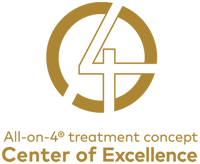Oral Surgery
Oral Surgery
Impacted Canine Tooth Treatment in the Dallas-Fort Worth Area
An impacted tooth simply means that it is “stuck” and cannot erupt into function. Patients frequently develop problems with impacted third molar (wisdom) teeth (see Wisdom Teeth Removal under Procedures). Since there is rarely a functional need for wisdom teeth, they are usually extracted if they develop problems. The maxillary cuspid (upper canine) is the second most common tooth to become impacted. The cuspid tooth is a critical tooth in the dental arch as it plays an important role in your bite. They are designed to be the first teeth that touch when your jaws close together, so they guide the rest of the teeth into the proper bite.
Normally, the maxillary cuspid teeth are the last of the front teeth to erupt into place. They usually come into place around age 13 and cause any space left between the upper front teeth to close tight together. If a cuspid tooth gets impacted, every effort is made to get it to erupt into its proper position in the dental arch. The techniques involved to aid eruption can be applied to any impacted tooth in the upper or lower jaw, but most commonly they are applied to the maxillary cuspid (upper canine) teeth.
Early recognition of impacted canines is the key to successful treatment
The older the patient, the more likely an impacted cuspid tooth will not erupt by nature’s forces alone, even if the space is available for the tooth to fit in the dental arch. The American Association of Orthodontists recommends that a panorex screening X-ray along with a dental examination be performed on all dental patients at around the age of 7 years to count the teeth and determine if there are problems with eruption of the adult teeth.
Treating such a problem may involve an orthodontist placing braces to open spaces that allow for proper eruption of the adult teeth. Treatment may also require a referral to an oral surgeon for extraction of over-retained baby teeth and/or selected adult teeth that are blocking the eruption of the all-important cuspid teeth. Based on the situation and the age of the patient, the best course of action will be determined.
What happens if the canine will not erupt when proper space is available?
In cases where the cuspid teeth do not erupt spontaneously, the orthodontists and doctors work together to get these unerupted canines to erupt. Each case must be evaluated on an individual basis, but treatment will usually involve a combined effort between the orthodontist and the oral surgeon. The most common scenario will be to expose and bond the tooth with the oral surgeon after the space was created using braces placed by the orthodontist.
In a simple surgical procedure performed in the surgeon’s office, the tooth is exposed and the oral surgeon will bond an orthodontic bracket to the exposed tooth. The bracket will have a miniature chain attached to it. The chain will be temporarily attached to the orthodontic arch wire. Most of the time, the gum will be returned to its original location and sutured back with only the chain remaining visible as it exits a small hole in the gum.
Shortly after oral surgery (1-14 days) the patient will return to the orthodontist. A rubber band will be attached to the chain to put a light eruptive pulling force on the impacted tooth. This will begin the process of moving the tooth into its proper place in the dental arch.
What to expect from surgery to expose and bracket an impacted tooth:
The surgery to expose and bracket an impacted tooth is a very straight forward surgical procedure that is performed in the oral surgeon’s office. For most patients, it is performed under IV sedation if the patient desires to be asleep. You can expect a limited amount of bleeding from the surgical sites after surgery. There may be some swelling from holding the lip up to visualize the surgical site. A soft, bland diet is recommended at first, but you may resume your normal diet as soon as you feel comfortable chewing. Your doctor could see you 7–10 days after surgery to evaluate the healing process and make sure you are maintaining good oral hygiene. You should plan to see your orthodontist within 1-14 days to activate the eruption process by applying the proper rubber band to the chain on your tooth.
Please call DFW Oral & Maxillofacial Surgery today if you want to learn more about receiving an impacted canine tooth surgery in Dallas-Fort Worth Irving, Mesquite, and Ennis, Texas.

